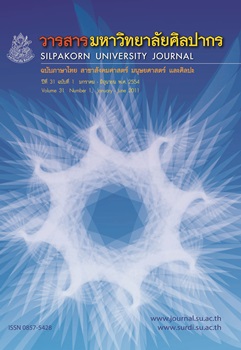รายงานการวิจัยการศึกษาปัจจัยที่ส่งผลต่อผลสัมฤทธิ์ทางการเรียนคณิตศาสตร์ ของนักเรียนในช่วงชั้นที่ 4 ในโรงเรียนสาธิตมหาวิทยาลัยศิลปากร The Study of Factors’ Influence toward Mathematic Learning Achievement in Level Four of the Demonstration School of Silpakorn University
Main Article Content
Abstract
บทคัดย่อ
การวิจัยครั้งนี้มีวัตถุประสงค์เพื่อ 1.) ศึกษาปัจจัยที่ส่งผลต่อผลสัมฤทธิ์ทางการเรียนคณิตศาสตร์ของนักเรียนในช่วงชั้นที่ 4 ในโรงเรียนสาธิตมหาวิทยาลัยศิลปากร 2.) ทำนายผลสัมฤทธิ์ทางการเรียนคณิตศาสตร์จากปัจจัยด้านนักเรียน ปัจจัยด้านครอบครัวและปัจจัยด้านโรงเรียนกลุ่มตัวอย่างเป็นนักเรียนในช่วงชั้นที่ 4 คือชั้นมัธยมศึกษาปีที่ 4, 5 และ 6 ประจำปีการศึกษา 2551 ในโรงเรียนสาธิตมหาวิทยาลัยศิลปากรจำนวน 181 คน ซึ่งได้มาจากการสุ่มตัวอย่างโดยวิธีสุ่มแบบแบ่งชั้น โดยการเปิดตารางสำเร็จรูปของ Krejcie และ Morgan จากประชากรทั้งหมด 335 คน เครื่องมือที่ใช้คือ แบบสอบถามเกี่ยวกับปัจจัยด้านนักเรียน ปัจจัยด้านครอบครัว และปัจจัยด้านโรงเรียน ซึ่งสอบถามเกี่ยวกับรายได้ของผู้ปกครอง การสนับสนุนการเรียนของผู้ปกครอง เจตคติต่อวิชาคณิตศาสตร์ ความวิตกกังวลต่อการสอบคณิตศาสตร์ บริบทโรงเรียน และการจัดการเรียนการสอนของครู วิเคราะห์ข้อมูลโดยการคำนวณค่าสัมประสิทธิ์สหสัมพันธ์แบบเพียร์สันระหว่างตัวแปรทำนายกับผลสัมฤทธิ์ทางการเรียนคณิตศาสตร์ และสร้างสมการถดถอยพหุคูณ (Multiple Regression Equation)เพื่อทำนายผลสัมฤทธิ์ทางการเรียนคณิตศาสตร์ในรูปคะแนนมาตรฐานและคะแนนดิบผลการวิจัยพบว่า 1.) ปัจจัยที่ส่งผลต่อผลสัมฤทธิ์ทางการเรียนคณิตศาสตร์อย่างมีนัยสำคัญทางสถิติที่ระดับ 0.05 จำนวน 3 ตัวแปรเรยี งตามลำดับค่า่สัมประสิทธิ์สหสัมพันธ์จากมากไปหาน้อยคือ เจตคติต่อวิชาคณิตศาสตร์ รายได้ของผู้ปกครอง และความวิตกกังวลต่อการสอบคณิตศาสตร์ โดยตัวแปรที่ส่งผลทางบวกต่อผลสัมฤทธิ์ทางการเรียนคณิตศาสตร์ คือ เจตคติต่อวิชาคณิตศาสตร์ และรายได้ของผู้ปกครอง ส่วนตัวแปรที่ส่งผลทางลบต่อผลสัมฤทธิ์ทางการเรียนคณิตศาสตร์ คือความวิตกกังวลต่อการสอบคณิตศาสตร์2.) ตัวแปรทำนายที่ส่งผลต่อผลสัมฤทธิ์ทางการเรียนคณิตศาสตร์อย่างมีนัยสำคัญทางสถิติที่ระดับ 0.05 มี 2ตัวแปรคือ เจตคติต่อวิชาคณิตศาสตร์ (x2) และความวิตกกังวลต่อการสอบคณิตศาสตร์ (x3) ร่วมกันทำนายผลสัมฤทธิ์ทางการเรียนคณิตศาสตร์ได้อย่างมีนัยสำคัญทางสถิติที่ระดับ 0.05 ได้ร้อยละ 9.4 และหาสมการทำนายในรูปคะแนนมาตรฐาน และในรูปคะแนนดิบ ได้ดังนี้
^Z= 0.257 z2 – 0.179z3^Y= 7.105 + 0.02681x2 – 0.03375x3
คำสำคัญ: 1. การเรียนคณิตศาสตร์. 2. ผลสัมฤทธิ์ทางการเรียนคณิตศาสตร์.
Abstract
The purposes of this research were 1.) to study the factors influencing mathematics learning achievementin level four of the Demonstration school of Silpakorn University; and 2.) to predict mathematics learningachievement based on student factors, family factors and school factors.A sample of 181 students of the Demonstration School of Silpakorn University was taken fromstudents studying in level four, academic year 2008, using stratified random sampling of the population ineach room of Mathayom Suksa 4, 5 and 6 using the table of Krejcie and Morgan from a population of 335.The instruments used were questionnaires asking about student factors, family factors and school factorsincluding basic data, income of parents, attitude toward learning mathematics, anxiety toward mathematicstesting, school environment, and learning and teaching in school. The data were treated utilizing bi-variantcorrelation statistics to find the Pearson’s product – moment correlation coefficient and stepwise multipleregression analysis to predict mathematics learning achievement in raw scores and standard scores.The results found that: 1.) Three factors influencing learning mathematics achievement at the 0.05level of significance ascending from coefficient correlation were attitude toward learning mathematics, incomeof parents, anxiety toward mathematics testing. Positive influential factors toward learning mathematicsachievement were attitude toward learning mathematics and income of parents and the negative influentialfactors toward learning mathematics achievement was anxiety toward mathematics testing. 2.) Two predictableinfluential factors toward learning mathematics achievement at the 0.05 level of significance were attitudetoward mathematics learning (x2), and anxiety toward mathematics testing (x3) that could predict learningmathematics achievement at the 0.05 level of significance of approximately 9.4 % and the predictabilityequations in raw scores and standard scores were^Z= 0.257 z2 – 0.179z3^Y= 7.105 + 0.02681x2 – 0.03375x3
Keywords: 1. Teaching of mathematics. 2. Achievement in mathematics.


